西方文化第2次作业_标准答案4
- 格式:docx
- 大小:19.02 KB
- 文档页数:7
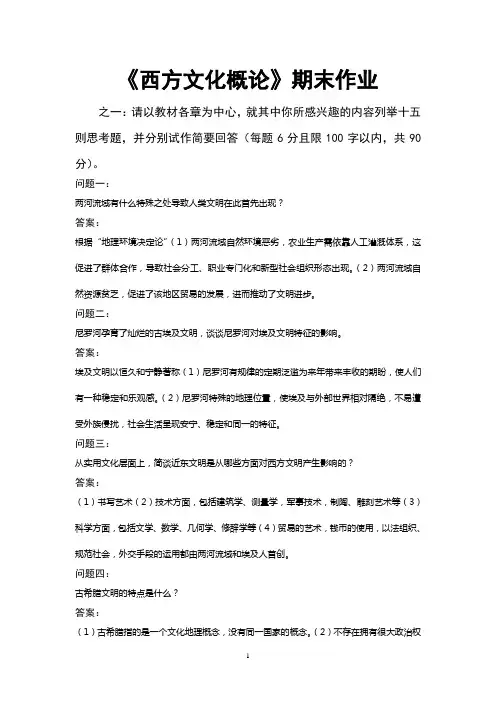
《西方文化概论》期末作业之一:请以教材各章为中心,就其中你所感兴趣的内容列举十五则思考题,并分别试作简要回答(每题6分且限100字以内,共90分)。
问题一:两河流域有什么特殊之处导致人类文明在此首先出现?答案:根据“地理环境决定论”(1)两河流域自然环境恶劣,农业生产需依靠人工灌溉体系,这促进了群体合作,导致社会分工、职业专门化和新型社会组织形态出现。
(2)两河流域自然资源贫乏,促进了该地区贸易的发展,进而推动了文明进步。
问题二:尼罗河孕育了灿烂的古埃及文明,谈谈尼罗河对埃及文明特征的影响。
答案:埃及文明以恒久和宁静著称(1)尼罗河有规律的定期泛滥为来年带来丰收的期盼,使人们有一种稳定和乐观感。
(2)尼罗河特殊的地理位置,使埃及与外部世界相对隔绝,不易遭受外族侵扰,社会生活呈现安宁、稳定和同一的特征。
问题三:从实用文化层面上,简谈近东文明是从哪些方面对西方文明产生影响的?答案:(1)书写艺术(2)技术方面,包括建筑学、测量学,军事技术,制陶、雕刻艺术等(3)科学方面,包括文学、数学、几何学、修辞学等(4)贸易的艺术,钱币的使用,以法组织、规范社会,外交手段的运用都由两河流域和埃及人首创。
问题四:古希腊文明的特点是什么?答案:(1)古希腊指的是一个文化地理概念,没有同一国家的概念。
(2)不存在拥有很大政治权利和干预世俗生活的宗教力量。
(3)关注人类自身问题,对人本主义和理性精神的不懈追求是希腊文化的根本特征。
问题五:雅典是如何成为希腊地区一大强盛城邦的?答案:雅典被视为希腊民主制的典范,其新形式的政体有两个鲜明特征:任期限制和责任制,将权力与责任联系起来。
雅典所推行的一系列带有首创性的政治改革使其摆脱了长期内政的困扰,经济实力和政治影响均得到加强。
问题六:戏剧被誉为古希腊文学的最高成就,简述你对希腊戏剧的认识。
答案:希腊戏剧以一种舞台表演艺术形式出现,包括悲剧和喜剧。
悲剧主要表现的是主人公的英雄行为,其形象高大雄伟,气势壮烈磅礴,具有永恒的艺术魅力和道德教化作用。
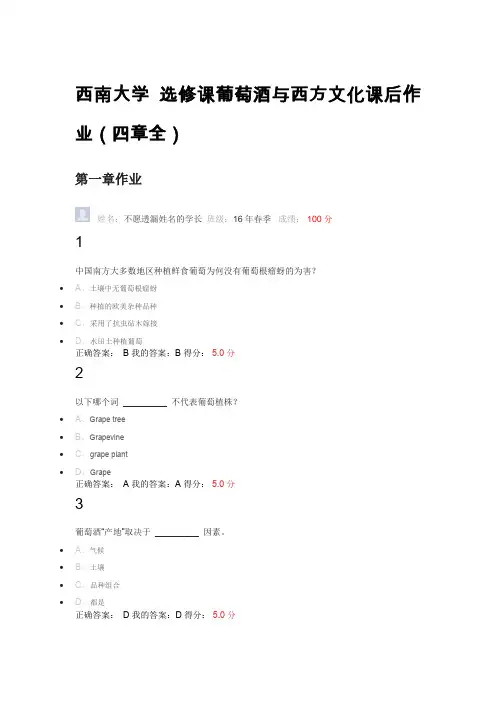
西南大学选修课葡萄酒与西方文化课后作业(四章全)第一章作业姓名:不愿透漏姓名的学长班级:16年春季成绩:100分1中国南方大多数地区种植鲜食葡萄为何没有葡萄根瘤蚜的为害?•A、土壤中无葡萄根瘤蚜•B、种植的欧美杂种品种•C、采用了抗虫砧木嫁接•D、水田土种植葡萄正确答案:B我的答案:B得分:5.0分2以下哪个词_________ 不代表葡萄植株?•A、Grape tree•B、Grapevine•C、grape plant•D、Grape正确答案:A我的答案:A得分:5.0分3葡萄酒“产地”取决于_________ 因素。
•A、气候•B、土壤•C、品种组合•D、都是正确答案:D我的答案:D得分:5.0分4赤霞珠Cabernet-Sauvignon属于_________ 颜色葡萄品种?•A、黑色•B、紫色•C、红色•D、白色正确答案:A我的答案:A得分:5.0分5非洲著名的葡萄酒生产国是指_________ 。
•A、阿尔及利亚•B、科特迪瓦•C、刚果•D、南非正确答案:D我的答案:D得分:5.0分6生产天然甜葡萄酒需要_________ 气候。
•A、湿润的冬季•B、冷凉的春季•C、干热的夏季•D、气爽的秋季正确答案:C我的答案:C得分:5.0分7葡萄根瘤蚜来自于_________ 。
•A、亚洲•B、欧洲•C、非洲•D、美洲正确答案:D我的答案:D得分:5.0分8霞多丽Chardonnay主要用于酿造_________ 。
•A、红葡萄酒•B、白葡萄酒•C、干邑酒•D、香槟酒正确答案:B我的答案:B得分:5.0分9葡萄属于_________ 作物。
•A、一年生•B、二年生•C、多年生•D、都不是正确答案:C我的答案:C得分:5.0分10以下哪种葡萄品种属酿酒葡萄_________?•A、巨峰•B、玫瑰香•C、赤霞珠•D、意大利正确答案:C我的答案:C得分:5.0分11葡萄蔓上拴羊,游牧民发现了_________ 技术。
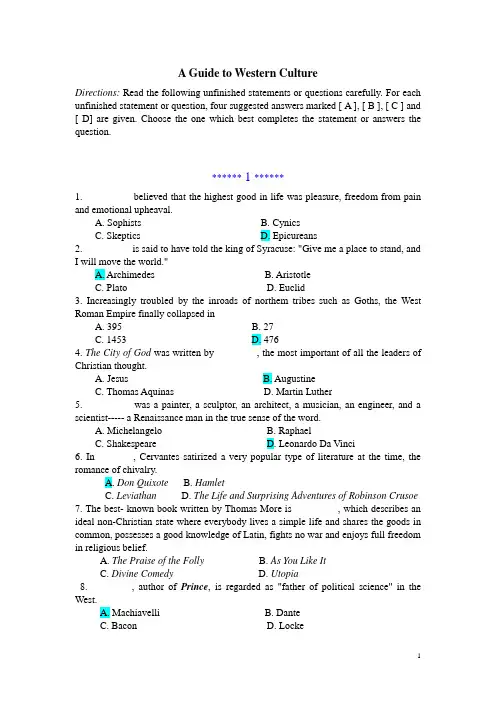
A Guide to Western CultureDirections: Read the following unfinished statements or questions carefully. For each unfinished statement or question, four suggested answers marked [ A ], [ B ], [ C ] and [ D] are given. Choose the one which best completes the statement or answers the question.****** 1 ******1. _________ believed that the highest good in life was pleasure, freedom from pain and emotional upheaval.A. SophistsB. CynicsC. SkepticsD. Epicureans2. _________ is said to have told the king of Syracuse: "Give me a place to stand, andI will move the world."A. ArchimedesB. AristotleC. PlatoD. Euclid3. Increasingly troubled by the inroads of northem tribes such as Goths, the West Roman Empire finally collapsed in _________A. 395B. 27C. 1453D. 4764. The City of God was written by ________, the most important of all the leaders of Christian thought.A. JesusB. AugustineC. Thomas AquinasD. Martin Luther5. _________ was a painter, a sculptor, an architect, a musician, an engineer, and a scientist----- a Renaissance man in the true sense of the word.A. MichelangeloB. RaphaelC. ShakespeareD. Leonardo Da Vinci6. In _______, Cervantes satirized a very popular type of literature at the time, the romance of chivalry.A. Don QuixoteB. HamletC. LeviathanD. The Life and Surprising Adventures of Robinson Crusoe7. The best- known book written by Thomas More is ________ , which describes an ideal non-Christian state where everybody lives a simple life and shares the goods in common, possesses a good knowledge of Latin, fights no war and enjoys full freedom in religious belief.A. The Praise of the FollyB. As You Like ItC. Divine ComedyD. Utopia8. ________, author of Prince, is regarded as "father of political science" in the West.A. MachiavelliB. DanteC. BaconD. Locke9. In The Revolution of Heavenly Orbs,________ put forward his theory that the sun, not the earth, is the center of the universe.A. KeplerB. GalileoC. NewtonD. Copernicus10. During the _________ century, the modern scientific method began to take shape, which emphasized observation and experimentation before formulating a final explanation or generalization.A. 18thB. 15 thC. 16 thD. 17 th11. _______ said, "Knowledge is power."A.. Isaac NewtonB. Francis BaconC. John LockeD. Marx12. In Faust,_______ drew on an immense variety of cultural material----theological, mythological, philosophical, political, economic, scientific, aesthetic, musical, and literary.A. GoetheB. DefoeC. RousseauD. Byron13. Which of the following is not regarded as a romantic writer?A. WordsworthB. ShelleyC. PushkinD. Balzac14. The most frequent themes of Romanticism include all of the following except _________.A. the power of reasonB. individual freedomC. spontaneityD. love of nature15. "If winter comes, can Spring be far behind?" is the ending line of "Ode to the West Wind" by ________.A. WordsworthB. KeatsC. PushkinD. Shelley16. The composer of Swan Lake was ____, a genius in symphonic music.A. TchaikovskyB. ChopinC. BeethovenD. Mozart17. The naturalist school founded by Zola in late 19 th century intended ________.A. to attack the industrial injustice and urban evilsB. to give full play to the imagination of individualsC. to uphold the classical values such as harmony, balance, proportion and retraintD. to demonstrate the law of human conduct by a scientific study of "a slice of life"18. Which of the following novels was not written by Tolstoy?A. ResurrectionB. War and PeaceC. Crime and PunishmentD. Anna Karenina19. In his poems, Walt Whitman sang praises of all of the following value except ________.A. democracyB. the dignity of the individualC. the idyllic way of lifeD. the brotherhood of man20. Modernism was characterized by ________.A. a conscious rejection of established rules, traditions and conventionsB. the exploration of the inner life of the individual and the psychopathology of human relationsC. its intense interest in the bizarre, the mysterious, the unpredictable and the formlessD. all of the above.****** 2 ******1. Greek culture reached a high point of development in _________.A. 1,200B.C. B. 5th century B. C.C. 4th century B.C.D. 146 B. C.2. The masterpiece of engineering in Roman architecture is _________.A. the PathenonB. the ColossseumC. She-wolfD. the Ionic style of temple3. The Old Testament of the Bible is about _________.A. GodB. the doctrine of Jesus ChristC. the Laws of GodD. A and C4. Which of the following statements is true?A. Jesus was born in Galilee.B. Jesus was born in a synagogue.C. Jesus was born into a poor carpenter’s family.D. Jesus was bor n into a merchant’s family.5. Feudalism in Europe was mainly a system of _________.A. military serviceB. land holdingC. governmentD. B and C6. Which of the following statements is true about the Gothic style in architecture?A. The Gothic style flourished in the 18th century.B. The Gothic style started in France.C. Sculpture of Gothic style churches were based on the natural forces.D. Gothic style churches were solid but small.7. Renaissance means the revival of interest in _________.A. ancient Greek cultureB. ancient Roman cultureC. the BibleD. A and B8. The reasons for the decline of renaissance in Italy are _________.A. wars and class conflictsB. loss of supremacy in world trade as a result of the discovery of the new world and routes to IndiaC. the tightening of control of the Roman Catholic Church over thought, speech and publicationD. all of the above9. Which of the following died a prisoner?A. CopernicusB. NewtonC. KeplerD. Galileo10. The theory of the social contract was expounded by _________.A. Thomas HobbesB. Francis BaconC. John LockeD. A and C11. In economic thought, the enlightenment thinkers favored _________.A. government interventionB. balanced developmentC. the policy of laissezfaireD. strict regulation12. The author of "The Sorrows of Young Werther" is _________.A. GoetheB. DefoeC. SchillerD. Kant13. The Lakers refer to _________.A. Wordsworth and ColeridgeB. Byron and ShellyC. William Blake and KeatsD. None of the above14. The later Romantics in music refer to _________.A. Schuman and ChopinB. Verdi and WagnerC. Beethoven and MozartD. Haydn and Bach15. In Capital, Marx, after long and careful study, discovered that _________.A. it is men’s social being that determines their consciousnessB. activity is basicC. socialism would be realized through class struggleD. surplus value is the source of the wealth of the capitalist class16. The essence of Darwin’s theory of evolution is _________.A. immutable fixity of speciesB. natural selectionC. artificial selectionD. none of the above17. "The Cherry Orchard" was written by _________.A. DostoyevskyB. GogolC. CorkyD. Chekhov18. Which of the following was not written by Charles Dickens?A. David CopperfieldB. Hard TimesC. Vanity FairD. Oliver Twist19. The author of "Sons and Lovers" is _________.A. Henry JamesB. Virginia WoolfC. T.S. EliotD. D.H. Lawrence20. One of the chief representatives of the Theatre of the Absurd is _________.A. Kinsley AmisB. John OsborneC. Allen GinsbergD. Samuel Beckett****** 3 ******1. Socrates was _________.A. the teacher of AristotleB. the student of PlatoC. the teacher of PlatoD. the student of Aristotle2. One of the contributions the Romans made to European culture was _________.A. the Roman empireB. the slave systemC. the production of the great epic writerD. the Roman law3. The Book of Daniel describes _________.A. the struggle of the Jews against the Syrian ruleB. the prisoners in BabylonC. the story of Noah’s ArkD. the rule of King Solomon4. The Old Testament was originally written in _________.A. HebrewB. Aramaic dialectC. GreekD. Latin5. Which of the following is not included in the Code of Chivalry?A. Loyalty to his lord.B. Fighting for the church.C. Protection of the people.D. Respect for women of noble birth.6. The goal of the Crusades was_________.A. to re-control JerusalemB. to open path to ByzantineC. to regain the Holy land --- PalestineD. to open trade route to the east7. The essence of Renaissance philosophy was _________.A. the emphasis on the greatness of manB. the glorification of GodC. the emphasis on the giving up of worldly pleasureD. the importance of wealth8. Leonardo da Vinci, in his lifetime, put down his observation in notebooks running up to _________ volumes.A. 1, 000B. 5, 000C. 3, 000D. 4, 0009. "Knowledge is power" is one of the quotations from _________.A. John LockeB. Francis BaconC. Isaac NewtonD. Gotffried Wilhelm yon Leibniz10. The most important point in Descartes’ philosophy is _________.A. I think therefore I amB. I use my senses therefore I amC. I doubt therefore I amD. None of the above11. The most important forerunners of the Enlightenment were _________.A. V oltaire and RousseauB. Diderot and MontesquieuC. John Locke and Isaac NewtonD. None of the above12. Which of the following remarks was made by Rousseau?A. We hold these truths to be self-evident, that all men are created equal.(The Declaration of Independence 美国的《独立宣言》)B. The thirst after happiness is never extinguished in the heart of man.(Rousseau卢梭)C. Love truth, but pardon error. (V oltaire伏尔泰)D. Liberty consists in the freedom to do everything which injures no one else.(Declaration of the Rights of Man and of the Citizen(1789)法国的《人权宣言》)13. Romanticism was a movement in Europe _________.A. in the late 19th century and early 20th centuryB. in the 19th centuryC. in the late 17th century and early 18th centuryD. in the late 18th century and early 19th century14. The two most important works of Victor Hugo’s are _________.A. Atala and Rene(Chateaubriand夏多布里昂)B. Ivanhoe and The Heart of Mid – lothianWalter Scott的《艾凡赫》又译《撒克逊劫后英雄传》以及《中洛辛郡的心脏》C. Notre Dame de Paris and Les MiserablesD. Eugene Onegin and Boris Godunov普希金pushkin的《叶甫盖尼·奥涅金》和《鲍里斯·戈都诺夫》15. The man who applied Darwi n’s evolution to society was_________.A. Yah FuB. Thomas HuxleyC. Alfred Russel WallaceD. Herbert Spencer16. According to Marx,the most important thing about Feuerbach was _________.A. he proclaimed materialismB. he supported HegelC. he supported the utopian socialistsD. he put forward the idea of class struggle17. "Sunflower" was the work of _________.A. van GoghB. Paul GauguinC. Claude MonetD. Gustave Courbet18. Which of the following works is not written by Thomas Hardy?A. Far from the Madding Crowd.B. The Return of the Native.C. Tess of the d'Urberyvilles.D. A Tale of Two Cities.19. William Butler Yeats was a(n) _________ poet.A. EnglishB. ScottishC. AmericanD. Irish20. "A Portrait of the Artist as a Young Man" was an autobiographical novel by _________.A. Ezra PoundB. William FaulknerC. James JoyceD. Ernest Hemingway****** 4 ******1. Which of the following is not true about Aristotle?A. In Aristotle the great humanist and the great man of science meet.B. Aristotle founded the school of the Stoics.C. Aristotle was tutor of Alexander.D. Aristotle wrote many books on logic, politics, poetry, rhetoric and other subjects.2. Which of the following statements is true about the Roman Empire?A. The Roman Empire had never been divided.B. The Roman Empire was divided into East and West in 395 A. D.C. The Roman Empire was later called Byzantium.D. The Roman Empire was conquered by the Turks in the 15th century.3. The Bible has been regarded as __________.A. a religious bookB. literatureC. record of great mindsD. all of the above4. The Catholic Church should be characterized as__________.A. a loosely organized religious institutionB. a highly centralized European organizationC. a highly centralized and disciplined international organizationD. a highly centralized and disciplined western organization.5. The Crusades were wars between __________.A. the Arabs and the Christian PilgrimsB. the Turks and the Christians in Western EuropeC. the Christians in Western Europe and the MoslemsD. the Arabs and the Turks6. St. Thomas Aquinas defended in his works __________.A. feudal hierarchy of societyB. divine power of feudal rulersC. the Pope' s supremacy over secular rulersD. all of the above7. The motto Montaigne put down in the essays was __________.A. What do I know?B. I doubt therefore I think.C. Give me a place to stand, and I will move the world.D. Only to stand out of my light.8. Vasco da Gama was a Portuguese navigator who __________.A. discovered the Cape of Good HopeB. discovered the route to India round the Cape of Good HopeC. explored the mouth of the AmazonD. was the first to visit Cuba and Haiti9. Which of the following laws was discovered by Newton?A. Law of buoyancy.B. Law of falling bodies.C. Law of relativity.D. Law of universal gravitation.10. In Locke' s political philosophy, the chief reason for the institution of civil government was __________.A. the protection of private propertyB. the upholding of free thinkingC. the abolishment of the rule of the churchD. regulation of economy11. Which of the following is not true about the developments of the Industrial Revolution?A. The substitution of water power for human power.B. The introduction of machine.C. The beginning of the factory system.D. The growth of modem capitalism and the working class.12. "Man is born free, and everywhere he is in chains. "This is a remark made by __________.A. V oltaireB. RousseauC. DiderotD. Moliere13. In the works of __________, one can see the spirit of the Age of Reason.A. HandelB. HaydnC. BachD. Mozart14. The poem of Byron' s that was translated into Chinese at the turn of the 20th century is __________.A. Don JuanB. Defence of PoetryC. Ode to a NightingaleD. Isles of Greece15. Throughout his life, Beethoven struggled to pass on through his music __________.A. the spirit of the French RevolutionB. the spirit of Byronic heroesC. ideas of a moral natureD. the praise of natural beauty16. __________ is considered to be the poet of the piano.A. MozartB. ChopinC.SchubertD. Schumann17. Which of the following works was not written by Charles Dickens?A. A Tale of Two Cities.B. The Mayor of Casterbridge.C. David Copperfield.D. Pickwick Papers.18. The author of the short story The Necklace was __________.A. O' HenryB. Jack LondonC. Mark TwainD. Maupassant19. "The apparition of these faces in the crowd/Petals on a wet, black bough. "The author of these lines was __________.A. William FaulknerB. Ezra PoundC. T. S. EliotD. William Butler Yeats20. __________was regarded as the greatest Russian literary figure of the 20th century.A. SholokhovB. TolstoyC. ChekhovD. Gorky****** 5 ******I. The contribution of ancient Greeks to world civilization is _________A. Athenian democracyB. The Olympic GamesC. The epics of HomerD. All of the above2. Which of the following is true about Herodotus?A. He is called " Father of History".B. He wrote about the wars between Athens and Sparta.C. He contributed greatly to tragic art.D. He used clever parody in his writing.3. Genesis of the Old Testament tells about __________A. the fall of manB. the creation of the worldC. Noah’s ArkD. all of the above.4. The leader of the slave uprising in 73 B. C. was _________A. NeroB. MosesC. SpartacusD. Abraham5. The great contribution of St. Jerome was __________A. the building of monasteriesB. the translation of Old and New Testaments into LatinC. the setting up of the church systemD. none of the above6. The main classes under feudalism in Western Europe were __A. monks, lords and townspeopleB. clergy, knights and peasantsC. knights, peasants and townspeopleD. clergy, lords and peasants7. Which of the following is not true about Dante?A. Dante was a great Italian poet.B. Dante wrote Beowulf.C. Dante wrote his masterpiece in Italian.D. Dante was a great political thinker.8. John Wycliffe was twice condemned as a heretic because of __________A. his teaching philosophy at OxfordB. his vigorous attack on orthodox church doctrinesC. his clerical associations and activitiesD. A&C9. Scientists in the 17th century, such as Galileo and Newton, attached great importance to ________A. deductive reasoningB. classical authorityC. direct observation and experimentD. humanist learning10. The method that Francis Bacon introduced in inquiry was _________.A. practicalB. deductive reasoningC. inductionD. experiment11. The characteristic of Dutch art in the early 17th century was ________.A. that it was still mainly religious paintingsB. that it recorded the familiar scenes and everyday life of the timeC. that it was mainly portraits of noble familiesD. that the theme was mainly court life12. Who was the first one to put forward the doctrine of separation of powers?A. LockeB. HobbesC. V oltaireD. Montesquieu13. Diderot is best known as ________.A. the author of Persian Letter s(Montesquieu)B. the author of the Origin of Human Inequality(Rousseau)C. the editor of the EncyclopedieD. the author of Philosophical Thoughts(Diderot)14. The lines "And mask in every face I meet / Masks of weakness, masks of woe" are written by _______.A. William BlakeB. SchillerC. ByronD. Keats15.B. LermontovC. ChekhovD. Turgenev16. A work jointly written by Marx and Engels is ________.A. CapitalB. The Manifesto of the Communist PartyC. Thesis on FeuerbachD. Socialism: Utopian and Scientific17. Which author won the Nobel Prize in 1925?A. Thomas HardyB. George EliotC. George Bernard ShawD. Henry James18. Which novel was acclaimed as the greatest of all anti-slavery manifestoes'?.A. Leaves of GrassB. Uncle Tom's Cabi nC. The Portrait of a LadyD. Dead Souls19. _______ was the discoverer of X - rays.A. RontgenB. Madame CurieC. RutherfordD. Einstein20. The author of The Interpretation of Dreams wasA. T. S. EliotB. James JoyceC. D. H. Lawrence D. Sigmund Freud****** 6 ******1. Who were considered as people by the ancient Athens?A. Women citizensB. AdultsC. Adult male citizensD. Foreigners and children2. Which of the following is true about Dialogues?A. Dialogues was a book written by Socrates.B. Dialogues was a record of life of Plato.C. Dialogues was a record of Socrates written by Plato.D. Dialogues was a record of Socrates's sayings by his followers.3. The great deed that David performed was ____.A. he took the Hebrews back to CanaanB. he killed Goliath, the philistine giantC. he went to the top of the mountain in Sinai to receive message from (~dD. none of the above4. In the early days of Christianity, it was a religion of _____.A. the richB. the poorC. the ruling classD. all people5. Which of the following statements about knighthood is not true?A. A nobleman was born a knight.B. Knighthood had to be earned.C. One had to be trained in order to become a knight.D. After being dubbed a knight, he had to observe the Code of Chivalry.6. The Inquisition was ______A. a church court set up to try hereticsB. an organization for church investigationC. a court in many kingdomsD. the decision - making body of the church7. Art to Michelangelo was a means by which_____.A. he expressed his opposition to the despotic ruleB. he made inquiry into the realityC. he expressed his vision of manD. B and C8. Counter- Reformation means that the Roman Catholic Church _____.A. suppressed the Reformation movement by forceB. refused to accept any reformC. re-established itself as a dynamic force in European affairs by introducing reforms and improvementsD. ganged up with the Spanish monarchy to set up the Inquisition9. Kepler's contribution to astronomy isA. his discovery of the law of inertiaB. his discovery of the Ptolemaic systemC. his discovery of the three laws of planetary motionD. none of the above10. In Essay Concerning Human Understanding, John Locke stated that .__A. all our knowledge sprang from experienceB. knowledge was powerC. every man was enemy to every manD. the world was made up of simple, active substances11. The symbolic event of the French Revolution in 1789 was _____.A. the issuance of the Declaration of IndependenceB. the founding of the First RepublicC. the seizure of the BastilleD. the publication of The Spirit of the Laws12. V oltaire was noted for his_____.A. witB. satireC. passionD. A and B13. In Critique of Pure Reason, Kant argued that________.A. knowledge is the joint product of both sense and reasonB. creation is never complete; it is ever going onC. virtue can be sustained without religious beliefD. man's greatest ills are not natural but are made by man himself14. The Lyrical Ballads was written by _________.A. ShelleyB. Wordsworth and ColeridgeC. Blake and KeatsD. Byran and Shelley15. The line "Beauty is truth, truth beauty" comes from_________.A. WordsworthB. ByronC. KeatsD. Blake16. In developing Marxist philosophy, Marx and Engels accepted _______ in German classical philosophy.A. Hegel's dialecticsB. Feuerbach's metaphysicsC. Feuerbach's materialismD. A and C17. Balzac's monumental work was ________.A. Divine ComedyB. The Human ComedyC. The Brothers KaramazovD. Les Miserables18. The author of A Doll's House was ________.A. George Bernard ShawB. ChekhovC. Henric IbsenD. Leo Tolstoy19. Which of the following works was written by William Faulkner?A. The Waste LandB. DublinersC. CantosD. The Sound and the Fury20. The poem Howl was written by ________.A. Kingsley AmisB. John OsborneC. Allen GinsbergD. Ezra Pound****** Division 1 ******Division1:1-5 DCBBC 6-10 CAACC****** Division 2 ******Division2:1-5 DCABB 6-8 BCC****** Division 3 ******Division3: 1-5 ADDBB 6-8 DDCCB****** Division 4 ******Division 4:1-5 BCCDA 6-8 CBDCC****** Division 5******Division 5:1-5 CBADC 6-8 ADBCC****** Division 6******Division 6:1-5 CBADA 6-8 DCA****** Division 7******Division 7:1-5 CDDAB 6-8 CADBA****** Division 8************ Division 9************ Division 10 ******Division 10:1-6 DADBDC 7-12 CCBBDB。
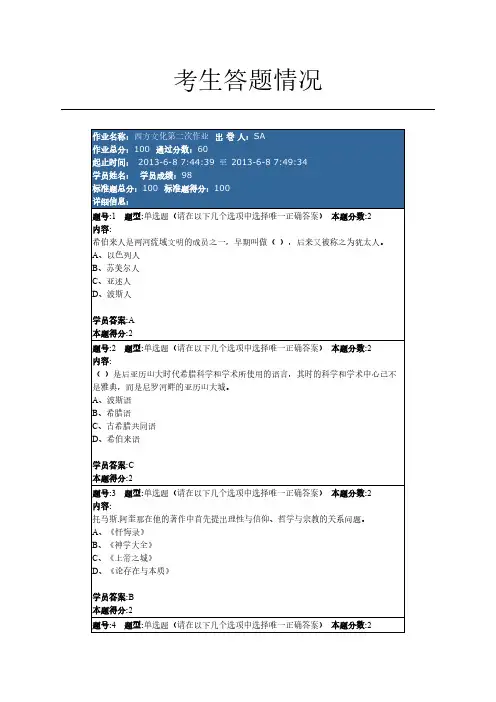
考生答题情况内容:( )拉斐尔的一幅经典之作,描绘了柏拉图派哲学家和亚里士多德派哲学家之间的和谐。
A、《蒂曼乌斯篇》B、《米利都学派》C、《岩间圣母》D、《雅典学院》学员答案:D本题得分:2题号:5 题型:单选题(请在以下几个选项中选择唯一正确答案)本题分数:2内容:德莱塞作品包括( )对现实的反映和批判颇为深刻。
A、《欲望三部曲》B、《白鲸》C、《激流三部曲》D、《蚀》学员答案:A本题得分:2题号:6 题型:单选题(请在以下几个选项中选择唯一正确答案)本题分数:2内容:16世纪,在欧洲诸国,掀起了一场声势浩大、震撼教廷的(),对后世影响深远,恩格斯称它为“第一号资产阶级革命”。
A、文艺复兴运动B、宗教改革C、工业革命D、启蒙运动学员答案:B本题得分:2题号:7 题型:单选题(请在以下几个选项中选择唯一正确答案)本题分数:2内容:()是启蒙运动对专制主义进行批判的武器.也是近代民主理论的核心内容。
A、“民主集中制”B、“天赋人权说”C、“主权在民说”D、“自由主义”学员答案:B本题得分:2题号:8 题型:单选题(请在以下几个选项中选择唯一正确答案)本题分数:2内容:狂飙突进运动是18世纪70年代~80年代初西方的一场文学运动,发生在(),历时十五年。
A、美国B、英国C、德国D、意大利学员答案:C本题得分:2题号:9 题型:单选题(请在以下几个选项中选择唯一正确答案)本题分数:2内容:( )是唯心主义辩证法的集大成者,18世纪末到19世纪初的德意志古典哲学的著名代表人物。
A、海德格尔B、费尔巴哈C、康德D、黑格尔学员答案:D本题得分:2题号:10 题型:单选题(请在以下几个选项中选择唯一正确答案)本题分数:2内容:英国是现实主义文学出现较早和成为气候的国家之一,19世纪30年代末至40年代爆发的( )是社会冲突和劳资矛盾激化的重要表现和反映。
A、“宪章运动”B、里昂工人运动C、西西里亚纺织工人起义D、经济大萧条学员答案:A本题得分:2题号:11 题型:单选题(请在以下几个选项中选择唯一正确答案)本题分数:2内容:1620年9月,102名清教徒乘上“五月花”号船只离开荷兰,向北美洲进发。
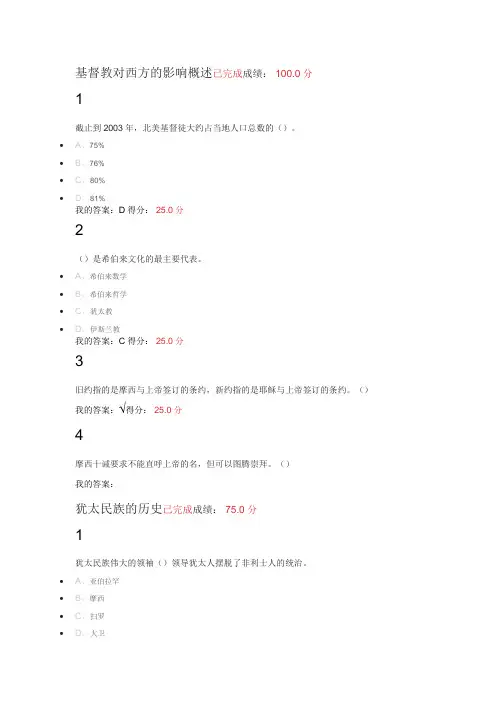
基督教对西方的影响概述已完成成绩:100.0分1截止到2003年,北美基督徒大约占当地人口总数的()。
•A、75%•B、76%•C、80%•D、81%我的答案:D得分:25.0分2()是希伯来文化的最主要代表。
•A、希伯来数学•B、希伯来哲学•C、犹太教•D、伊斯兰教我的答案:C得分:25.0分3旧约指的是摩西与上帝签订的条约,新约指的是耶稣与上帝签订的条约。
()我的答案:√得分:25.0分4摩西十诫要求不能直呼上帝的名,但可以图腾崇拜。
()我的答案:×犹太民族的历史已完成成绩:75.0分1犹太民族伟大的领袖()领导犹太人摆脱了非利士人的统治。
•A、亚伯拉罕•B、摩西•C、扫罗•D、大卫我的答案:A得分:0.0分2犹太人把总是被别人奴役的责任归到自己身上后,他们的苦难意识逐渐转化为了()意识。
•A、不幸•B、罪孽•C、敌视•D、欢快我的答案:B得分:25.0分3公元前2世纪末1世纪初,犹太民族受()的统治。
•A、新巴比伦•B、波斯•C、希腊•D、罗马我的答案:D得分:25.0分4罗马人与希腊人一样民族成长环境造就了他们乐观开朗的特性。
()我的答案:√得分:25.0分犹太教的发展与基督教的产生已完成成绩:75.0分1下面犹太教派别中()信奉耶稣就是拯救他们的弥赛亚。
•A、法利赛人•B、撒都该人•C、吉伦特派•D、加利利派我的答案:A得分:0.0分2()制定了现代普遍使用的公历历法。
•A、保罗•B、尤里乌斯·恺撒•C、小狄奥尼修斯•D、希律王我的答案:C得分:25.0分3基督教是从犹太教中分化出来的,一直都保持着和睦相处。
()我的答案:×得分:25.0分4按照我们现在使用的公历来算,耶稣诞生于公元元年。
()我的答案:×得分:25.0分“基督”的来源已完成成绩:75.0分1耶稣认为下面哪种律法最重要?()•A、安息日不可做任何工•B、不可妄称神的名字•C、不能崇拜别的偶像•D、爱上帝我的答案:D得分:25.0分2下面不属于耶稣的观点的是()。

西方文化概论任务2附答案单选题(1/10)、在公元1世纪初,一个犹太教的支派把加利利的拿撒勒人耶稣认作弥赛亚,即基督,他们在与正统派的斗争中逐渐脱离犹太教,形成了()的雏形。
(2分)A、犹太教B、基督教C、天主教D、新教(2/10)、中世纪欧洲经济生活的基本单元是“小而全”的()。
(2分)A、农场B、庄园C、山寨D、公社(3/10)、现代的西方人通常把希腊罗马文化称为古典文化,而把自己所处的文化称为()。
(2分)A、现代文化B、基督教文化C、中世纪文化(4/10)、受基督教唯灵主义理想和灵肉二元论观念的影响,中世纪人们在现实生活中越是苦难深重,在精神就越发把虚无缥缈的天国景象想象得美妙无比。
这种强烈的反差表现在中世纪一切文化作品中,尤其是骑士文学和()建筑中。
(2分)A、哥特式B、巴洛克式C、廊柱式D、券柱式(5/10)、从弥赛亚运动的“末世论”到“()”的发展,是基督教最终摆脱犹太教而成为一种世界性宗教的重要标志。
(2分)A、复活说B、救赎说C、有神论(6/10)、犹太教的核心是律法和祭祀,基督教的核心则是()。
(2分)A、理想和道德B、信仰和道德C、道德和宗教D、宗教和理想(7/10)、在中世纪全盛时期(12、13世纪),意大利、法国和英国的几乎每一座较大的城市里都建立了大学,其中法国的巴黎大学和英国的()成为全欧洲最著名的大学。
(2分)A、牛津大学B、加州大学C、麻省理工大学D、里斯本大学(8/10)、根据犹太教的传述,早在公元前13世纪末叶犹太人被埃及征服者掠到埃及去做苦役时,在犹太人中间就出现了一位先知摩西。
摩西在西乃山上与上帝立约,即(),定下了十条诫命,即摩西十诫。
(2分)A、新约B、旧约C、圣经(9/10)、最先将基督教的福音传播到罗马城的是耶稣的门徒()。
(2分)A、犹大B、彼得C、安德烈D、雅各(10/10)、11世纪在意大利的博洛尼亚产生了西欧第一个由专业性学校合并而成的多学科性质的学校,这种学校被称为“()”。
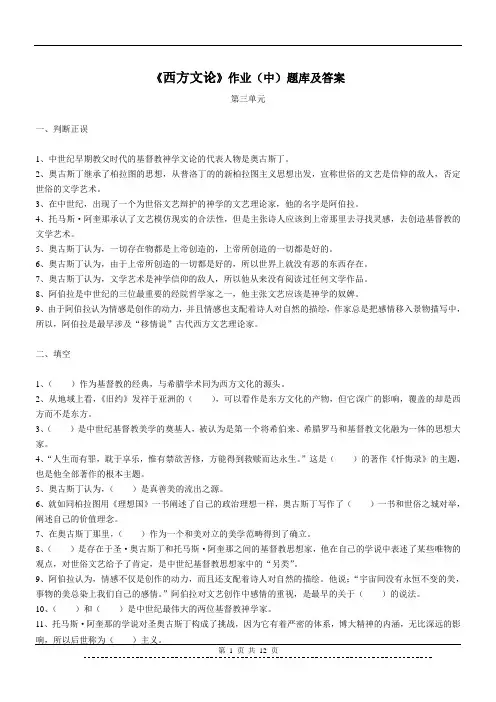
《西方文论》作业(中)题库及答案第三单元一、判断正误1、中世纪早期教父时代的基督教神学文论的代表人物是奥古斯丁。
2、奥古斯丁继承了柏拉图的思想,从普洛丁的的新柏拉图主义思想出发,宣称世俗的文艺是信仰的敌人,否定世俗的文学艺术。
3、在中世纪,出现了一个为世俗文艺辩护的神学的文艺理论家,他的名字是阿伯拉。
4、托马斯·阿奎那承认了文艺模仿现实的合法性,但是主张诗人应该到上帝那里去寻找灵感,去创造基督教的文学艺术。
5、奥古斯丁认为,一切存在物都是上帝创造的,上帝所创造的一切都是好的。
6、奥古斯丁认为,由于上帝所创造的一切都是好的,所以世界上就没有恶的东西存在。
7、奥古斯丁认为,文学艺术是神学信仰的敌人,所以他从来没有阅读过任何文学作品。
8、阿伯拉是中世纪的三位最重要的经院哲学家之一,他主张文艺应该是神学的奴婢。
9、由于阿伯拉认为情感是创作的动力,并且情感也支配着诗人对自然的描绘,作家总是把感情移入景物描写中,所以,阿伯拉是最早涉及“移情说”古代西方文艺理论家。
二、填空1、()作为基督教的经典,与希腊学术同为西方文化的源头。
2、从地域上看,《旧约》发祥于亚洲的(),可以看作是东方文化的产物,但它深广的影响,覆盖的却是西方而不是东方。
3、()是中世纪基督教美学的奠基人,被认为是第一个将希伯来、希腊罗马和基督教文化融为一体的思想大家。
4、“人生而有罪,耽于享乐,惟有禁欲苦修,方能得到救赎而达永生。
”这是()的著作《忏悔录》的主题,也是他全部著作的根本主题。
5、奥古斯丁认为,()是真善美的流出之源。
6、就如同柏拉图用《理想国》一书阐述了自己的政治理想一样,奥古斯丁写作了()一书和世俗之城对举,阐述自己的价值理念。
7、在奥古斯丁那里,()作为一个和美对立的美学范畴得到了确立。
8、()是存在于圣·奥古斯丁和托马斯·阿奎那之间的基督教思想家,他在自己的学说中表述了某些唯物的观点,对世俗文艺给予了肯定,是中世纪基督教思想家中的“另类”。
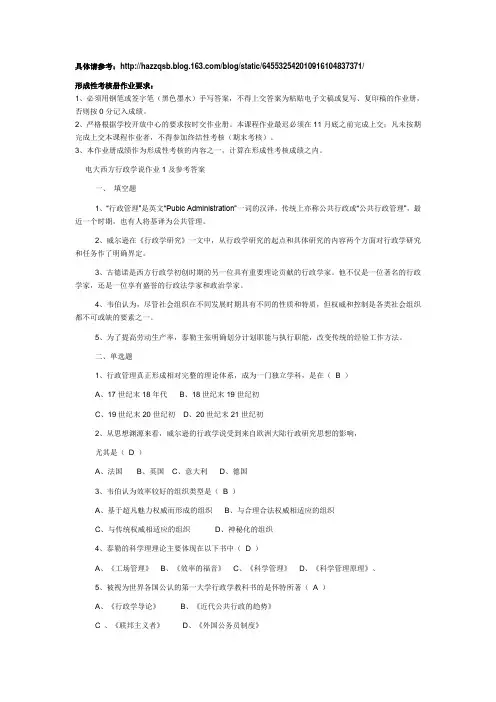
具体请参考:/blog/static/645532542010916104837371/形成性考核册作业要求:1、必须用钢笔或签字笔(黑色墨水)手写答案,不得上交答案为粘贴电子文稿或复写、复印稿的作业册,否则按0分记入成绩。
2、严格根据学校开放中心的要求按时交作业册。
本课程作业最迟必须在11月底之前完成上交;凡未按期完成上交本课程作业者,不得参加终结性考核(期末考核)。
3、本作业册成绩作为形成性考核的内容之一,计算在形成性考核成绩之内。
电大西方行政学说作业1及参考答案一、填空题1、“行政管理”是英文“Pubic Administration”一词的汉泽,传统上亦称公共行政或“公共行政管理”,最近一个时期,也有人将基译为公共管理。
2、威尔逊在《行政学研究》一文中,从行政学研究的起点和具体研究的内容两个方面对行政学研究和任务作了明确界定。
3、古德诺是西方行政学初创时期的另一位具有重要理论贡献的行政学家。
他不仅是一位著名的行政学家,还是一位享有盛誉的行政法学家和政治学家。
4、韦伯认为,尽管社会组织在不同发展时期具有不同的性质和特质,但权威和控制是各类社会组织都不可或缺的要素之一。
5、为了提高劳动生产率,泰勒主张明确划分计划职能与执行职能,改变传统的经验工作方法。
二、单选题1、行政管理真正形成相对完整的理论体系,成为一门独立学科,是在(B )A、17世纪末18年代B、18世纪末19世纪初C、19世纪末20世纪初D、20世纪末21世纪初2、从思想渊源来看,威尔逊的行政学说受到来自欧洲大陆行政研究思想的影响,尤其是( D )A、法国B、英国C、意大利D、德国3、韦伯认为效率较好的组织类型是(B )A、基于超凡魅力权威而形成的组织B、与合理合法权威相适应的组织C、与传统权威相适应的组织D、神秘化的组织4、泰勒的科学理理论主要体现在以下书中(D )A、《工场管理》B、《效率的福音》C、《科学管理》D、《科学管理原理》、5、被视为世界各国公认的第一大学行政学教科书的是怀特所著(A )A、《行政学导论》B、《近代公共行政的趋势》C 、《联邦主义者》D、《外国公务员制度》三、多选择题1、古德诺把行政功能从内部再作了划分,包括有(A 、B、D、E、F )A、执行功能B、司法功能C、政法功能D、准司法功能E、统计功能F、半科学功能2、韦伯认为,官僚制具有巨大的优越性,这种优越性具体体现在以下方面(A、B、C、D )A、严密性B、合理性C、稳定性D、普适性E、系统性F、科学性3、被誉为“科学管理之父”的泰勒有长期、丰富的企业工作实践,先后做过(A、B、C、D、E、F、)A、机械工人B、车间管理员C、技师D、工长E、总工程师F、总经理4、法约尔将管理定义为以下诸要素(A、B、D、E、F )A、计划B、组织C、决策D、指挥E、协调F、控制5、怀特认为败坏官纪的因素主要包括(A、B、C、D、E、F )A、缺乏奖励B、惩罚无度C、损失创制权D、疏略社交生活E、调资不及时F、取消权利四、简答题1、真正形成一个相对完整的理论体系的行政学是如何产生的?(答案P2—4 )行政管理真正形成相对完整的理论体系,成为一门独立学科,是19世纪末20世纪初的事情。
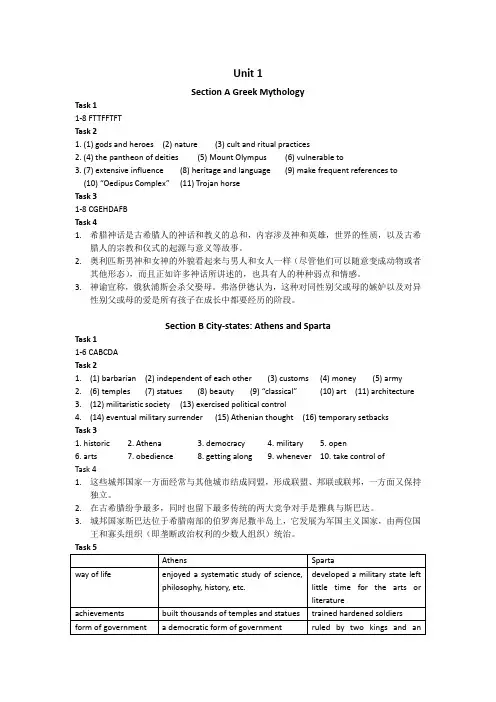
Unit 1Section A Greek MythologyTask 11-8 FTTFFTFTTask 21. (1) gods and heroes (2) nature (3) cult and ritual practices2. (4) the pantheon of deities (5) Mount Olympus (6) vulnerable to3. (7) extensive influence (8) heritage and language (9) make frequent references to (10) “Oedipus Complex”(11) Trojan horseTask 31-8 CGEHDAFBTask 41.希腊神话是古希腊人的神话和教义的总和,内容涉及神和英雄,世界的性质,以及古希腊人的宗教和仪式的起源与意义等故事。
2.奥利匹斯男神和女神的外貌看起来与男人和女人一样(尽管他们可以随意变成动物或者其他形态),而且正如许多神话所讲述的,也具有人的种种弱点和情感。
3.神谕宣称,俄狄浦斯会杀父娶母。
弗洛伊德认为,这种对同性别父或母的嫉妒以及对异性别父或母的爱是所有孩子在成长中都要经历的阶段。
Section B City-states: Athens and SpartaTask 11-6 CABCDATask 21.(1) barbarian (2) independent of each other (3) customs (4) money (5) army2.(6) temples (7) statues (8) beauty (9) “classical”(10) art (11) architecture3.(12) militaristic society (13) exercised political control4.(14) eventual military surrender (15) Athenian thought (16) temporary setbacksTask 31. historic2. Athena3.democracy4. military5. open6.arts7. obedience8. getting along9. whenever 10. take control ofTask 41.这些城邦国家一方面经常与其他城市结成同盟,形成联盟、邦联或联邦,一方面又保持独立。

A Guide to Western CultureDirections: Read the following unfinished statements or questions carefully. For each unfinished statement or question, four suggested answers marked [ A ], [ B ], [ C ] and [ D] are given. Choose the one which best completes the statement or answers the question.****** 1 ******1. _________ believed that the highest good in life was pleasure, freedom from pain and emotional upheaval.A. SophistsB. CynicsC. SkepticsD. Epicureans2. _________ is said to have told the king of Syracuse: "Give me a place to stand, andI will move the world."A. ArchimedesB. AristotleC. PlatoD. Euclid3. Increasingly troubled by the inroads of northem tribes such as Goths, the West Roman Empire finally collapsed in _________A. 395B. 27C. 1453D. 4764. The City of God was written by ________, the most important of all the leaders of Christian thought.A. JesusB. AugustineC. Thomas AquinasD. Martin Luther5. _________ was a painter, a sculptor, an architect, a musician, an engineer, and a scientist----- a Renaissance man in the true sense of the word.A. MichelangeloB. RaphaelC. ShakespeareD. Leonardo Da Vinci6. In _______, Cervantes satirized a very popular type of literature at the time, the romance of chivalry.A. Don QuixoteB. HamletC. LeviathanD. The Life and Surprising Adventures of Robinson Crusoe7. The best- known book written by Thomas More is ________ , which describes an ideal non-Christian state where everybody lives a simple life and shares the goods in common, possesses a good knowledge of Latin, fights no war and enjoys full freedom in religious belief.A. The Praise of the FollyB. As You Like ItC. Divine ComedyD. Utopia8. ________, author of Prince, is regarded as "father of political science" in the West.A. MachiavelliB. DanteC. BaconD. Locke9. In The Revolution of Heavenly Orbs,________ put forward his theory that the sun, not the earth, is the center of the universe.A. KeplerB. GalileoC. NewtonD. Copernicus10. During the _________ century, the modern scientific method began to take shape, which emphasized observation and experimentation before formulating a final explanation or generalization.A. 18thB. 15 thC. 16 thD. 17 th11. _______ said, "Knowledge is power."A.. Isaac NewtonB. Francis BaconC. John LockeD. Marx12. In Faust,_______ drew on an immense variety of cultural material----theological, mythological, philosophical, political, economic, scientific, aesthetic, musical, and literary.A. GoetheB. DefoeC. RousseauD. Byron13. Which of the following is not regarded as a romantic writer?A. WordsworthB. ShelleyC. PushkinD. Balzac14. The most frequent themes of Romanticism include all of the following except _________.A. the power of reasonB. individual freedomC. spontaneityD. love of nature15. "If winter comes, can Spring be far behind?" is the ending line of "Ode to the West Wind" by ________.A. WordsworthB. KeatsC. PushkinD. Shelley16. The composer of Swan Lake was ____, a genius in symphonic music.A. TchaikovskyB. ChopinC. BeethovenD. Mozart17. The naturalist school founded by Zola in late 19 th century intended ________.A. to attack the industrial injustice and urban evilsB. to give full play to the imagination of individualsC. to uphold the classical values such as harmony, balance, proportion and retraintD. to demonstrate the law of human conduct by a scientific study of "a slice of life"18. Which of the following novels was not written by Tolstoy?A. ResurrectionB. War and PeaceC. Crime and PunishmentD. Anna Karenina19. In his poems, Walt Whitman sang praises of all of the following value except ________.A. democracyB. the dignity of the individualC. the idyllic way of lifeD. the brotherhood of man20. Modernism was characterized by ________.A. a conscious rejection of established rules, traditions and conventionsB. the exploration of the inner life of the individual and the psychopathology of human relationsC. its intense interest in the bizarre, the mysterious, the unpredictable and the formlessD. all of the above.****** 2 ******1. Greek culture reached a high point of development in _________.A. 1,200B.C. B. 5th century B. C.C. 4th century B.C.D. 146 B. C.2. The masterpiece of engineering in Roman architecture is _________.A. the PathenonB. the ColossseumC. She-wolfD. the Ionic style of temple3. The Old Testament of the Bible is about _________.A. GodB. the doctrine of Jesus ChristC. the Laws of GodD. A and C4. Which of the following statements is true?A. Jesus was born in Galilee.B. Jesus was born in a synagogue.C. Jesus was born into a poor carpenter’s family.D. Jesus was bor n into a merchant’s family.5. Feudalism in Europe was mainly a system of _________.A. military serviceB. land holdingC. governmentD. B and C6. Which of the following statements is true about the Gothic style in architecture?A. The Gothic style flourished in the 18th century.B. The Gothic style started in France.C. Sculpture of Gothic style churches were based on the natural forces.D. Gothic style churches were solid but small.7. Renaissance means the revival of interest in _________.A. ancient Greek cultureB. ancient Roman cultureC. the BibleD. A and B8. The reasons for the decline of renaissance in Italy are _________.A. wars and class conflictsB. loss of supremacy in world trade as a result of the discovery of the new world and routes to IndiaC. the tightening of control of the Roman Catholic Church over thought, speech and publicationD. all of the above9. Which of the following died a prisoner?A. CopernicusB. NewtonC. KeplerD. Galileo10. The theory of the social contract was expounded by _________.A. Thomas HobbesB. Francis BaconC. John LockeD. A and C11. In economic thought, the enlightenment thinkers favored _________.A. government interventionB. balanced developmentC. the policy of laissezfaireD. strict regulation12. The author of "The Sorrows of Young Werther" is _________.A. GoetheB. DefoeC. SchillerD. Kant13. The Lakers refer to _________.A. Wordsworth and ColeridgeB. Byron and ShellyC. William Blake and KeatsD. None of the above14. The later Romantics in music refer to _________.A. Schuman and ChopinB. Verdi and WagnerC. Beethoven and MozartD. Haydn and Bach15. In Capital, Marx, after long and careful study, discovered that _________.A. it is men’s social being that determines their consciousnessB. activity is basicC. socialism would be realized through class struggleD. surplus value is the source of the wealth of the capitalist class16. The essence of Darwin’s theory of evolution is _________.A. immutable fixity of speciesB. natural selectionC. artificial selectionD. none of the above17. "The Cherry Orchard" was written by _________.A. DostoyevskyB. GogolC. CorkyD. Chekhov18. Which of the following was not written by Charles Dickens?A. David CopperfieldB. Hard TimesC. Vanity FairD. Oliver Twist19. The author of "Sons and Lovers" is _________.A. Henry JamesB. Virginia WoolfC. T.S. EliotD. D.H. Lawrence20. One of the chief representatives of the Theatre of the Absurd is _________.A. Kinsley AmisB. John OsborneC. Allen GinsbergD. Samuel Beckett****** 3 ******1. Socrates was _________.A. the teacher of AristotleB. the student of PlatoC. the teacher of PlatoD. the student of Aristotle2. One of the contributions the Romans made to European culture was _________.A. the Roman empireB. the slave systemC. the production of the great epic writerD. the Roman law3. The Book of Daniel describes _________.A. the struggle of the Jews against the Syrian ruleB. the prisoners in BabylonC. the story of Noah’s ArkD. the rule of King Solomon4. The Old Testament was originally written in _________.A. HebrewB. Aramaic dialectC. GreekD. Latin5. Which of the following is not included in the Code of Chivalry?A. Loyalty to his lord.B. Fighting for the church.C. Protection of the people.D. Respect for women of noble birth.6. The goal of the Crusades was_________.A. to re-control JerusalemB. to open path to ByzantineC. to regain the Holy land --- PalestineD. to open trade route to the east7. The essence of Renaissance philosophy was _________.A. the emphasis on the greatness of manB. the glorification of GodC. the emphasis on the giving up of worldly pleasureD. the importance of wealth8. Leonardo da Vinci, in his lifetime, put down his observation in notebooks running up to _________ volumes.A. 1, 000B. 5, 000C. 3, 000D. 4, 0009. "Knowledge is power" is one of the quotations from _________.A. John LockeB. Francis BaconC. Isaac NewtonD. Gotffried Wilhelm yon Leibniz10. The most important point in Descartes’ philosophy is _________.A. I think therefore I amB. I use my senses therefore I amC. I doubt therefore I amD. None of the above11. The most important forerunners of the Enlightenment were _________.A. V oltaire and RousseauB. Diderot and MontesquieuC. John Locke and Isaac NewtonD. None of the above12. Which of the following remarks was made by Rousseau?A. We hold these truths to be self-evident, that all men are created equal.(The Declaration of Independence 美国的《独立宣言》)B. The thirst after happiness is never extinguished in the heart of man.(Rousseau卢梭)C. Love truth, but pardon error. (V oltaire伏尔泰)D. Liberty consists in the freedom to do everything which injures no one else.(Declaration of the Rights of Man and of the Citizen(1789)法国的《人权宣言》)13. Romanticism was a movement in Europe _________.A. in the late 19th century and early 20th centuryB. in the 19th centuryC. in the late 17th century and early 18th centuryD. in the late 18th century and early 19th century14. The two most important works of Victor Hugo’s are _________.A. Atala and Rene(Chateaubriand夏多布里昂)B. Ivanhoe and The Heart of Mid – lothianWalter Scott的《艾凡赫》又译《撒克逊劫后英雄传》以及《中洛辛郡的心脏》C. Notre Dame de Paris and Les MiserablesD. Eugene Onegin and Boris Godunov普希金pushkin的《叶甫盖尼·奥涅金》和《鲍里斯·戈都诺夫》15. The man who applied Darwi n’s evolution to society was_________.A. Yah FuB. Thomas HuxleyC. Alfred Russel WallaceD. Herbert Spencer16. According to Marx,the most important thing about Feuerbach was _________.A. he proclaimed materialismB. he supported HegelC. he supported the utopian socialistsD. he put forward the idea of class struggle17. "Sunflower" was the work of _________.A. van GoghB. Paul GauguinC. Claude MonetD. Gustave Courbet18. Which of the following works is not written by Thomas Hardy?A. Far from the Madding Crowd.B. The Return of the Native.C. Tess of the d'Urberyvilles.D. A Tale of Two Cities.19. William Butler Yeats was a(n) _________ poet.A. EnglishB. ScottishC. AmericanD. Irish20. "A Portrait of the Artist as a Young Man" was an autobiographical novel by _________.A. Ezra PoundB. William FaulknerC. James JoyceD. Ernest Hemingway****** 4 ******1. Which of the following is not true about Aristotle?A. In Aristotle the great humanist and the great man of science meet.B. Aristotle founded the school of the Stoics.C. Aristotle was tutor of Alexander.D. Aristotle wrote many books on logic, politics, poetry, rhetoric and other subjects.2. Which of the following statements is true about the Roman Empire?A. The Roman Empire had never been divided.B. The Roman Empire was divided into East and West in 395 A. D.C. The Roman Empire was later called Byzantium.D. The Roman Empire was conquered by the Turks in the 15th century.3. The Bible has been regarded as __________.A. a religious bookB. literatureC. record of great mindsD. all of the above4. The Catholic Church should be characterized as__________.A. a loosely organized religious institutionB. a highly centralized European organizationC. a highly centralized and disciplined international organizationD. a highly centralized and disciplined western organization.5. The Crusades were wars between __________.A. the Arabs and the Christian PilgrimsB. the Turks and the Christians in Western EuropeC. the Christians in Western Europe and the MoslemsD. the Arabs and the Turks6. St. Thomas Aquinas defended in his works __________.A. feudal hierarchy of societyB. divine power of feudal rulersC. the Pope' s supremacy over secular rulersD. all of the above7. The motto Montaigne put down in the essays was __________.A. What do I know?B. I doubt therefore I think.C. Give me a place to stand, and I will move the world.D. Only to stand out of my light.8. Vasco da Gama was a Portuguese navigator who __________.A. discovered the Cape of Good HopeB. discovered the route to India round the Cape of Good HopeC. explored the mouth of the AmazonD. was the first to visit Cuba and Haiti9. Which of the following laws was discovered by Newton?A. Law of buoyancy.B. Law of falling bodies.C. Law of relativity.D. Law of universal gravitation.10. In Locke' s political philosophy, the chief reason for the institution of civil government was __________.A. the protection of private propertyB. the upholding of free thinkingC. the abolishment of the rule of the churchD. regulation of economy11. Which of the following is not true about the developments of the Industrial Revolution?A. The substitution of water power for human power.B. The introduction of machine.C. The beginning of the factory system.D. The growth of modem capitalism and the working class.12. "Man is born free, and everywhere he is in chains. "This is a remark made by __________.A. V oltaireB. RousseauC. DiderotD. Moliere13. In the works of __________, one can see the spirit of the Age of Reason.A. HandelB. HaydnC. BachD. Mozart14. The poem of Byron' s that was translated into Chinese at the turn of the 20th century is __________.A. Don JuanB. Defence of PoetryC. Ode to a NightingaleD. Isles of Greece15. Throughout his life, Beethoven struggled to pass on through his music __________.A. the spirit of the French RevolutionB. the spirit of Byronic heroesC. ideas of a moral natureD. the praise of natural beauty16. __________ is considered to be the poet of the piano.A. MozartB. ChopinC.SchubertD. Schumann17. Which of the following works was not written by Charles Dickens?A. A Tale of Two Cities.B. The Mayor of Casterbridge.C. David Copperfield.D. Pickwick Papers.18. The author of the short story The Necklace was __________.A. O' HenryB. Jack LondonC. Mark TwainD. Maupassant19. "The apparition of these faces in the crowd/Petals on a wet, black bough. "The author of these lines was __________.A. William FaulknerB. Ezra PoundC. T. S. EliotD. William Butler Yeats20. __________was regarded as the greatest Russian literary figure of the 20th century.A. SholokhovB. TolstoyC. ChekhovD. Gorky****** 5 ******I. The contribution of ancient Greeks to world civilization is _________A. Athenian democracyB. The Olympic GamesC. The epics of HomerD. All of the above2. Which of the following is true about Herodotus?A. He is called " Father of History".B. He wrote about the wars between Athens and Sparta.C. He contributed greatly to tragic art.D. He used clever parody in his writing.3. Genesis of the Old Testament tells about __________A. the fall of manB. the creation of the worldC. Noah’s ArkD. all of the above.4. The leader of the slave uprising in 73 B. C. was _________A. NeroB. MosesC. SpartacusD. Abraham5. The great contribution of St. Jerome was __________A. the building of monasteriesB. the translation of Old and New Testaments into LatinC. the setting up of the church systemD. none of the above6. The main classes under feudalism in Western Europe were __A. monks, lords and townspeopleB. clergy, knights and peasantsC. knights, peasants and townspeopleD. clergy, lords and peasants7. Which of the following is not true about Dante?A. Dante was a great Italian poet.B. Dante wrote Beowulf.C. Dante wrote his masterpiece in Italian.D. Dante was a great political thinker.8. John Wycliffe was twice condemned as a heretic because of __________A. his teaching philosophy at OxfordB. his vigorous attack on orthodox church doctrinesC. his clerical associations and activitiesD. A&C9. Scientists in the 17th century, such as Galileo and Newton, attached great importance to ________A. deductive reasoningB. classical authorityC. direct observation and experimentD. humanist learning10. The method that Francis Bacon introduced in inquiry was _________.A. practicalB. deductive reasoningC. inductionD. experiment11. The characteristic of Dutch art in the early 17th century was ________.A. that it was still mainly religious paintingsB. that it recorded the familiar scenes and everyday life of the timeC. that it was mainly portraits of noble familiesD. that the theme was mainly court life12. Who was the first one to put forward the doctrine of separation of powers?A. LockeB. HobbesC. V oltaireD. Montesquieu13. Diderot is best known as ________.A. the author of Persian Letter s(Montesquieu)B. the author of the Origin of Human Inequality(Rousseau)C. the editor of the EncyclopedieD. the author of Philosophical Thoughts(Diderot)14. The lines "And mask in every face I meet / Masks of weakness, masks of woe" are written by _______.A. William BlakeB. SchillerC. ByronD. Keats15.B. LermontovC. ChekhovD. Turgenev16. A work jointly written by Marx and Engels is ________.A. CapitalB. The Manifesto of the Communist PartyC. Thesis on FeuerbachD. Socialism: Utopian and Scientific17. Which author won the Nobel Prize in 1925?A. Thomas HardyB. George EliotC. George Bernard ShawD. Henry James18. Which novel was acclaimed as the greatest of all anti-slavery manifestoes'?.A. Leaves of GrassB. Uncle Tom's Cabi nC. The Portrait of a LadyD. Dead Souls19. _______ was the discoverer of X - rays.A. RontgenB. Madame CurieC. RutherfordD. Einstein20. The author of The Interpretation of Dreams wasA. T. S. EliotB. James JoyceC. D. H. Lawrence D. Sigmund Freud****** 6 ******1. Who were considered as people by the ancient Athens?A. Women citizensB. AdultsC. Adult male citizensD. Foreigners and children2. Which of the following is true about Dialogues?A. Dialogues was a book written by Socrates.B. Dialogues was a record of life of Plato.C. Dialogues was a record of Socrates written by Plato.D. Dialogues was a record of Socrates's sayings by his followers.3. The great deed that David performed was ____.A. he took the Hebrews back to CanaanB. he killed Goliath, the philistine giantC. he went to the top of the mountain in Sinai to receive message from (~dD. none of the above4. In the early days of Christianity, it was a religion of _____.A. the richB. the poorC. the ruling classD. all people5. Which of the following statements about knighthood is not true?A. A nobleman was born a knight.B. Knighthood had to be earned.C. One had to be trained in order to become a knight.D. After being dubbed a knight, he had to observe the Code of Chivalry.6. The Inquisition was ______A. a church court set up to try hereticsB. an organization for church investigationC. a court in many kingdomsD. the decision - making body of the church7. Art to Michelangelo was a means by which_____.A. he expressed his opposition to the despotic ruleB. he made inquiry into the realityC. he expressed his vision of manD. B and C8. Counter- Reformation means that the Roman Catholic Church _____.A. suppressed the Reformation movement by forceB. refused to accept any reformC. re-established itself as a dynamic force in European affairs by introducing reforms and improvementsD. ganged up with the Spanish monarchy to set up the Inquisition9. Kepler's contribution to astronomy isA. his discovery of the law of inertiaB. his discovery of the Ptolemaic systemC. his discovery of the three laws of planetary motionD. none of the above10. In Essay Concerning Human Understanding, John Locke stated that .__A. all our knowledge sprang from experienceB. knowledge was powerC. every man was enemy to every manD. the world was made up of simple, active substances11. The symbolic event of the French Revolution in 1789 was _____.A. the issuance of the Declaration of IndependenceB. the founding of the First RepublicC. the seizure of the BastilleD. the publication of The Spirit of the Laws12. V oltaire was noted for his_____.A. witB. satireC. passionD. A and B13. In Critique of Pure Reason, Kant argued that________.A. knowledge is the joint product of both sense and reasonB. creation is never complete; it is ever going onC. virtue can be sustained without religious beliefD. man's greatest ills are not natural but are made by man himself14. The Lyrical Ballads was written by _________.A. ShelleyB. Wordsworth and ColeridgeC. Blake and KeatsD. Byran and Shelley15. The line "Beauty is truth, truth beauty" comes from_________.A. WordsworthB. ByronC. KeatsD. Blake16. In developing Marxist philosophy, Marx and Engels accepted _______ in German classical philosophy.A. Hegel's dialecticsB. Feuerbach's metaphysicsC. Feuerbach's materialismD. A and C17. Balzac's monumental work was ________.A. Divine ComedyB. The Human ComedyC. The Brothers KaramazovD. Les Miserables18. The author of A Doll's House was ________.A. George Bernard ShawB. ChekhovC. Henric IbsenD. Leo Tolstoy19. Which of the following works was written by William Faulkner?A. The Waste LandB. DublinersC. CantosD. The Sound and the Fury20. The poem Howl was written by ________.A. Kingsley AmisB. John OsborneC. Allen GinsbergD. Ezra Pound****** Division 1 ******Division1:1-5 DCBBC 6-10 CAACC****** Division 2 ******Division2:1-5 DCABB 6-8 BCC****** Division 3 ******Division3: 1-5 ADDBB 6-8 DDCCB****** Division 4 ******Division 4:1-5 BCCDA 6-8 CBDCC****** Division 5******Division 5:1-5 CBADC 6-8 ADBCC****** Division 6******Division 6:1-5 CBADA 6-8 DCA****** Division 7******Division 7:1-5 CDDAB 6-8 CADBA****** Division 8************ Division 9************ Division 10 ******Division 10:1-6 DADBDC 7-12 CCBBDB。
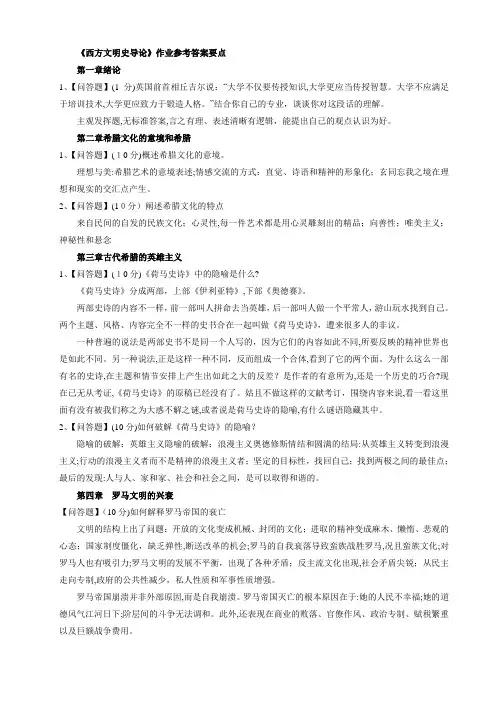
《西方文明史导论》作业参考答案要点第一章绪论1、【问答题】(1分)英国前首相丘吉尔说:“大学不仅要传授知识,大学更应当传授智慧。
大学不应满足于培训技术,大学更应致力于锻造人格。
”结合你自己的专业,谈谈你对这段话的理解。
主观发挥题,无标准答案,言之有理、表述清晰有逻辑,能提出自己的观点认识为好。
第二章希腊文化的意境和希腊1、【问答题】(10分)概述希腊文化的意境。
理想与美:希腊艺术的意境表述;情感交流的方式:直觉、诗语和精神的形象化;玄同忘我之境在理想和现实的交汇点产生。
2、【问答题】(10分)阐述希腊文化的特点来自民间的自发的民族文化;心灵性,每一件艺术都是用心灵雕刻出的精品;向善性;唯美主义;神秘性和悬念第三章古代希腊的英雄主义1、【问答题】(10分)《荷马史诗》中的隐喻是什么?《荷马史诗》分成两部,上部《伊利亚特》,下部《奥德赛》。
两部史诗的内容不一样,前一部叫人拼命去当英雄,后一部叫人做一个平常人,游山玩水找到自己。
两个主题、风格、内容完全不一样的史书合在一起叫做《荷马史诗》,遭来很多人的非议。
一种普遍的说法是两部史书不是同一个人写的,因为它们的内容如此不同,所要反映的精神世界也是如此不同。
另一种说法,正是这样一种不同,反而组成一个合体,看到了它的两个面。
为什么这么一部有名的史诗,在主题和情节安排上产生出如此之大的反差?是作者的有意所为,还是一个历史的巧合?现在已无从考证,《荷马史诗》的原稿已经没有了。
姑且不做这样的文献考订,围绕内容来说,看一看这里面有没有被我们称之为大惑不解之谜,或者说是荷马史诗的隐喻,有什么谜语隐藏其中。
2、【问答题】(10分)如何破解《荷马史诗》的隐喻?隐喻的破解:英雄主义隐喻的破解:浪漫主义奥德修斯情结和圆满的结局:从英雄主义转变到浪漫主义;行动的浪漫主义者而不是精神的浪漫主义者;坚定的目标性,找回自己;找到两极之间的最佳点;最后的发现:人与人、家和家、社会和社会之间,是可以取得和谐的。
《外国文学2》练习测试题库一、填空1、英国第一部现实主义小说是。
2、诗人是英国感伤主义诗歌和浪漫主义诗歌的桥梁。
3、是法国第一个启蒙作家,他的小说是法国第一部获得广泛影响的启蒙文学作品。
4、《拉奥孔》是德国戏剧作家文学理论家的一部重要的美学著作。
5、被称为“美国文学之父”的作家是。
6、是济慈最著名的颂诗,体现了诗人对自然之美的追求。
7、新英格兰超验主义运动的基地是,是新英格兰超验主义运动的原动力,是美国文化独立的旗手。
8、伏尔泰的文艺观主要体现在他的理论著作中。
9、“星期五”是小说中的人物形象。
10、卢梭的小说是直接模仿英国作家的小说《克拉丽莎·哈洛》写成的。
11、使拜伦成为“诗坛的拿破仑”的作品是。
12、被称为“众心之心”的诗人是。
13、雨果世界观和创作的主导思想是。
14、普希金的小说取材于普加乔夫起义。
15、狄德罗的小说代表作是。
16、卢梭著名的自传体小说是。
17、歌德的诗剧代表了启蒙主义文学的最高成就。
18、“如果冬天来了,春天还会远吗?”是诗人的诗句。
19、《草叶集》是美国诗人的代表作。
20、写出下列作品的作者:《解放了的普罗米修斯》、《茶花女》、《西里西亚的纺织工人》、《三个火枪手》、《白鲸》。
21、菲尔丁的小说代表了18实际英国现实主义小说的最高成就。
22、哥特式小说的代表作家是,他的代表作是。
23、斯塔尔夫人的两部理论著作和为法国浪漫主义奠定了理论基础。
24、“我的心摧毁了,武器没有摧毁,我倒下了,并没有失败。
”这是德国诗人的诗句,也可以被视为诗人一生的写照。
25、列出下列作品的作者:《四季》组诗、《威克菲尔德的牧师》、《天真汉》、《亲和力》、《教长的黑棉纱》。
26、18世纪法国文坛上享有“史诗诗人”的作家是,他的哲理小说的代表作是。
27、浮土德与古希腊美女的结合,象征着现代文化对古典“美”的追求。
他们婚后生下的儿子是,歌德通过他悼念英国浪漫主义诗人。
28、抒情歌谣集是由英国诗人和合著的。
XXX《外国文学》形考作业1-4参考答案形考作业1一.选择题(已知作品选择作者,每题2分,共10分)1、《诗学》a.XXXb.XXXc.XXXd.XXX2、《被缚的普罗米修斯》a.XXXb.XXXc.XXXd.XXX3、《埃涅阿斯纪》a.XXXb.XXXc.XXXd.XXX4、《麦克白》a.XXXb.XXXc.XXXd.XXX5、《》a.XXXb.薄伽丘c.XXXd.XXX二、填空题(每空2分,共20分)6、欧洲文学史上最古老的文学是古代(希腊罗马)文学。
它们在奴隶制条件下产生和发展,是欧洲文学史的源头。
8、《》分为《地狱》、《炼狱(又译《净界》)》和《天堂》三部。
9、中世纪初期民间文学的主要作品有日耳曼人的英雄史诗《希尔德布兰特之歌》,XXX人的史诗《贝奥武普》,冰岛人民的“埃达”和“萨迦”,芬兰人民的史诗《卡勒瓦拉》。
10、文艺复兴时期法国具有民主倾向的人文主义代表作家是(XXX),他的代表作是《巨人传》。
三、简答题(每题15分,共45分)11、人文主义文学有哪些主要特征?答题要点:人文主义文学是文艺复兴时期欧洲文学的主题。
它的特点有:首先在头脑内容上反封建反教会,揭露封建贵族和教士的恶德败行,嘲讽教会禁欲主义和封建道德,抨击封建割据,赞美国家民族统一,施展阐发人文主义理想。
其次在创作方法上主要采用现实主义,提倡“摹仿自然”摒弃中古梦幻、寓意和象征的手法,表现出来生动活泼的写实精神。
第三在文学发展上形成民族文学,各民族采用本民族语言写作,强调反映民族生活,使文学富有民族特色。
12、简述欧洲中世纪法国骑士文学的分类和主要内容。
答题要点:在宗教文学盛行的同时,民间文学也在开展。
英雄史诗是个中的重要品种。
中世纪初期,主要有凯尔特人的有关XXX 和XXX的英雄故事以及关于XXX的传说,日耳曼人的英雄史诗《希尔德布兰特之歌》,XXX人的史诗《贝奥武甫》,冰岛人的“埃达”(意为“歌谣”)和“萨迦”(意为“英雄传说”),芬兰人的史诗《卡勒瓦拉》等。
题号希伯来人是两河流域文明的成员之一,早期叫做(),后来又被称之为犹太人。
、以色列人、苏美尔人、亚述人、波斯人学员答案题号()是后亚历山大时代希腊科学和学术所使用的语言,其时的科学和学术中心已不是雅典,而是尼罗河畔的亚历山大城。
、波斯语、希腊语、古希腊共同语、希伯来语学员答案题号托马斯.阿奎那在他的著作中首先提出理性与信仰、哲学与宗教的关系问题。
、《忏悔录》、《神学大全》、《上帝之城》、《论存在与本质》学员答案题号( )拉斐尔的一幅经典之作,描绘了柏拉图派哲学家和亚里士多德派哲学家之间的和谐。
、《蒂曼乌斯篇》、《米利都学派》、《岩间圣母》、《雅典学院》学员答案题号德莱塞作品包括( )对现实的反映和批判颇为深刻。
、《欲望三部曲》、《白鲸》、《激流三部曲》、《蚀》学员答案题号世纪,在欧洲诸国,掀起了一场声势浩大、震撼教廷的(),对后世影响深远,恩格斯称它为“第一号资产阶级革命”。
、文艺复兴运动、宗教改革、工业革命、启蒙运动学员答案题号()是启蒙运动对专制主义进行批判的武器.也是近代民主理论的核心内容。
、“民主集中制”、“天赋人权说”、“主权在民说”、“自由主义”学员答案题号狂飙突进运动是世纪年代~年代初西方的一场文学运动,发生在(),历时十五年。
、美国、英国、德国、意大利学员答案题号( )是唯心主义辩证法的集大成者,世纪末到世纪初的德意志古典哲学的著名代表人物。
、海德格尔、费尔巴哈、康德、黑格尔学员答案题号英国是现实主义文学出现较早和成为气候的国家之一世纪年代末至年代爆发的( )是社会冲突和劳资矛盾激化的重要表现和反映。
、“宪章运动”、里昂工人运动、西西里亚纺织工人起义、经济大萧条学员答案题号年月,名清教徒乘上“五月花”号船只离开荷兰,向北美洲进发。
两个多月以后驶抵今麻萨诸塞湾海岸,清教徒们就在这里建立了居民点——()。
、弗吉尼亚、普利茅斯、新英格兰、宾夕法尼亚学员答案题号超验主义是一场思想解放运动,先表现为宗教,哲学思想中的改革,后扩展到文学创作领域,这一派思想的出发点是()。